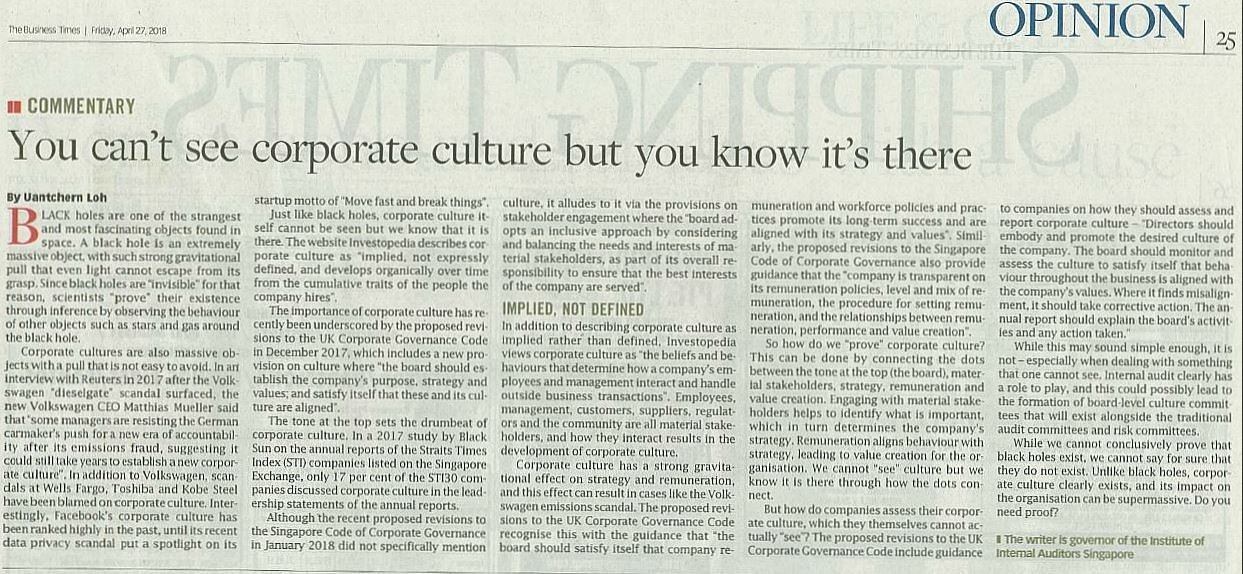Business Times explores culture with Uantchern Loh

Corporate culture: You can’t see it but you know it’s there
By Mr Uantchern Loh (first published in the Business Times on 27 April, 2018)
Black holes are one of the strangest and most fascinating objects found in space. A black hole is an extremely massive object, with such strong gravitational pull that even light cannot escape from its grasp. Since black holes are “invisible” for that reason, scientists “prove’ their existence through inference by observing the behaviour of other objects such as stars and gas around the black hole.
Corporate cultures are also massive objects with a pull that’s not easy to avoid. In an interview with Reuters in 2017 after the Volkswagen “dieselgate” scandal surfaced, Mr Matthias Mueller, the new Volkswagen CEO said that “some managers are resisting the German carmaker’s push for a new era of accountability after its emissions fraud, suggesting it could still take years to establish a new corporate culture.” In addition to Volkswagen, scandals at Wells Fargo, Toshiba and Kobe Steel have been blamed on corporate culture. Interestingly, Facebook’s corporate culture has been ranked highly in the past, until its recent data privacy scandal put a spotlight on its start-up motto of “Move fast and break things”.
Just like black holes, corporate culture itself cannot be seen but we know it’s there. The website, Investopedia describes corporate culture as “implied, not expressly defined, and develops organically over time from the cumulative traits of the people the company hires.”
The importance of corporate culture has recently been underscored by the proposed revisions to the UK Corporate Governance Code in December 2017, which includes a new provision on culture where “the board should establish the company’s purpose, strategy and values, and satisfy itself that these and its culture are aligned”.
The tone at the top sets the drumbeat of corporate culture. In a 2017 study by Black Sun on the annual reports of The Straits Times Index (STI) companies listed on the Singapore Exchange, only 17% of the STI30 companies discussed corporate culture in the leadership statements of the annual reports.
Although the recent proposed revisions to the Singapore Code of Corporate Governance in January 2018 did not specifically mention culture, it alludes to it via the provisions on stakeholder engagement where the “Board adopts an inclusive approach by considering and balancing the needs and interests of material stakeholders, as part of its overall responsibility to ensure that the best interests of the company are served.”
In addition to describing corporate culture as implied rather than defined, Investopedia views corporate culture as “the beliefs and behaviours that determine how a company's employees and management interact and handle outside business transactions.” Employees, management customers, suppliers, regulators and the community are all material stakeholders, and how they interact results in the development of corporate culture.
Corporate culture has a strong gravitational effect on strategy and remuneration, and this effect can result in cases like the Volkswagen emissions scandal. The proposed revisions to the UK Corporate Governance Code recognise this with the guidance that “the board should satisfy itself that company remuneration and workforce policies and practices promote its long-term success and are aligned with its strategy and values”. Similarly, the proposed revisions to the Singapore Code of Corporate Governance also provides guidance that the “company is transparent on its remuneration policies, level and mix of remuneration, the procedure for setting remuneration, and the relationships between remuneration, performance and value creation.”
So how do we “prove” corporate culture? This can be done by connecting the dots between tone at the top (the Board), material stakeholders, strategy, remuneration and value creation. Engaging with material stakeholders helps to identify what’s important, which in turn determines the company’s strategy. Remuneration aligns behaviour with strategy, leading to value creation for the organisation. We cannot “see” culture but we know it’s there through how the dots connect.
But how do companies assess their corporate culture, which they themselves cannot actually “see”?
The proposed revisions to the UK Corporate Governance Code include guidance to companies on how they should assess and report corporate culture - “Directors should embody and promote the desired culture of the company. The board should monitor and assess the culture to satisfy itself that behaviour throughout the business is aligned with the company’s values. Where it finds misalignment it should take corrective action. The annual report should explain the board’s activities and any action taken.”
While this may sound simple enough, it is not, especially when dealing with something that one cannot see. Internal audit clearly has a role to play, and this could possibly lead to the formation of Board-level culture committees that will exist alongside the traditional audit committees and risk committees.
While we cannot conclusively prove that black holes exist, we cannot say for sure that black holes don’t exist. Unlike black holes, corporate culture clearly exists and its impact on the organisation can be supermassive. Do you need prove?
The 1-2-3 of Corporate Culture
- The tone at the top sets the drumbeat of corporate culture. This means that the Board has the primary responsibility for oversight over culture. The tone at the top comprises the organisation’s mission (what do we do?), vision (what do we want to be?) and purpose (why do we do what we do?).
- Corporate culture is not just about “the way we do things around here”. It grows over time by how material stakeholders react to the tone at the top. Material stakeholders (the people most important to the organisation) includes employees, management, shareholders, customers, suppliers, regulators, government, NGOs, the community and society at large.
- We cannot “see” culture but it “appears” through how the dots are connected. These dots are the Board (tone at the top) material stakeholders, strategy, remuneration (reward) and value creation.

Uantchern Loh is the Asia-Pacific CEO of Black Sun Plc in Singapore. Mr. Loh also serves as governor of the Institute of Internal Auditors Singapore
